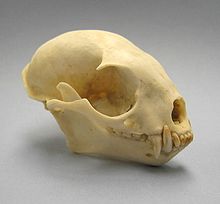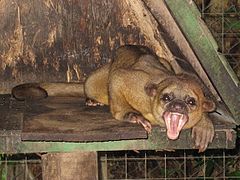- Kinkajou
-
For the meerkat on Meerkat Manor, see List of Meerkat Manor meerkats#Kinkajou.
Kinkajou 
Conservation status Scientific classification Kingdom: Animalia Phylum: Chordata Class: Mammalia Order: Carnivora Family: Procyonidae Genus: Potos
Geoffroy Saint-Hilaire & Cuvier, 1795Species: P. flavus Binomial name Potos flavus
(Schreber, 1774)
Kinkajou range The kinkajou (Potos flavus), also known as the honey bear (a name it shares with the sun bear), is a rainforest mammal of the family Procyonidae related to olingos, coatis, raccoons, and the ringtail and cacomistle. It is the only member of the genus Potos. Kinkajous may be mistaken for ferrets or monkeys, but are not closely related. Native to Central America and South America, this arboreal mammal is not an endangered species, though it is seldom seen by people because of its strict nocturnal habits. However, they are hunted for the pet trade, for their fur (to make wallets and horse saddles) and for their meat. The species has been included in Appendix III of CITES by Honduras, which means that exports from Honduras require an export permit and exports from other countries require a certificate of origin or re-export.[2] They may live up to 40 years in captivity.
Contents
Size and appearance
An adult kinkajou weighs 1.4–4.6 kg (3–10 lb). The adult body length is 40–60 cm (16–24 in); in addition to body length, the tail length is 40–60 cm (16–24 in).[3] The kinkajou's woolly fur consists of an outer coat of gold (or brownish-gray) overlapping a gray undercoat. It has large eyes and small ears. It also has short legs with five toes on each foot and sharp claws.[4][5]
Diet
Kinkajou skull
Although the kinkajou is classified in the order Carnivora and has sharp teeth, its omnivorous diet consists mainly of fruit. Kinkajous particularly enjoy figs. Studies have shown that 90% of their diet consists of (primarily ripe) fruit. To eat softer fruits they hold it with their forepaws, then scoop out the succulent pulp with their tongue. They may play an important role in seed dispersal. Leaves and flowers make up much of the other 10% of their diet.[6] They sometimes eat insects, particularly ants. It has been suggested, without direct evidence, that they may occasionally eat bird eggs and small vertebrates.[6] Their frugivorous habits are actually convergent with those of (diurnal) spider monkeys.[6]
The kinkajou's slender five-inch extrudable tongue helps the animal to obtain fruit and to lick nectar from flowers, so that it sometimes acts as a pollinator. (Nectar is also sometimes obtained by eating entire flowers.) Although captive specimens will avidly eat honey (hence the name "honey bear"), honey has not yet been observed in the diet of wild kinkajous.
Phylogeny
Olingos are similar to the kinkajou in morphology and habits. However, genetic studies have shown that kinkajous were an early offshoot of the ancestral procyonid line and are not closely related to any of the other extant procyonids.[7] The similarities between the kinkajou and olingos are thus an example of parallel evolution; the closest relatives of the olingos are actually the coatis.[7] The kinkajou is distinguished from olingos by its prehensile tail, its foreshortened muzzle, its extrudable tongue, and its lack of anal scent glands. The only other carnivoran with a prehensile tail is the binturong of Southeast Asia.
Kinkajous evolved in Central America and invaded the formerly isolated continent of South America several million years ago, as part of the Great American Interchange, when formation of the Isthmus of Panama made it possible to do so.[7]
Behavior
Like raccoons, kinkajous' remarkable manipulatory abilities rival those of primates. The kinkajou has a short-haired, fully prehensile tail (like some New World monkeys), which it uses as a "fifth hand" in climbing. It does not use its tail for grasping food. Scent glands near the mouth, on the throat, and on the belly allow kinkajous to mark their territory and their travel routes. Kinkajous sleep in family units and groom one another. While they are usually solitary when foraging, they occasionally forage in small groups, and sometimes associate with olingos (which are also frugivorous).[8]
A nocturnal animal, the kinkajou's peak activity is usually between about 7:00 PM and midnight, and again an hour before dawn. During daylight hours, kinkajous sleep in tree hollows or in shaded tangles of leaves, avoiding direct sunlight.
Kinkajous breed throughout the year, giving birth to one or occasionally two small babies after a gestation period of 112 to 118 days.
As pets
Kinkajous are sometimes kept as exotic pets. They are playful, generally quiet, docile, and have little odor. However, they can occasionally be aggressive. Kinkajous dislike sudden movements, noise, and being awake during the day. An agitated kinkajou may emit a scream and attack, usually clawing its victim and sometimes biting deeply. It has recently been discovered that pet kinkajous in the United States can be carriers of the roundworm Baylisascaris procyonis, which is capable of causing severe morbidity and even death in the owner, if infected.[9]
In El Salvador, Guatemala and Honduras pet kinkajous are commonly called micoleón, meaning "lion monkey". In Peru pet kinkajous are commonly referred to as "lirón". The lirón is often described as a "bear-monkey" or "bear-monkey hybrid".
They live an average of about 23 years in captivity, with a maximum recorded life span of 41 years.[10]
Subspecies
There are seven subspecies of kinkajou:[11]
- Potos flavus flavus
- Potos flavus chapadensis
- Potos flavus chiriquensis
- Potos flavus megalotus
- Potos flavus meridensis
- Potos flavus modestus
- Potos flavus nocturnus
References
- ^ Kays, R., Reid, F., Schipper, J. & Helgen, K. (2008). Potos flavus. In: IUCN 2008. IUCN Red List of Threatened Species. Downloaded on 26 January 2009.
- ^ "Appendices I, II and III: The CITES Appendices". http://www.cites.org/eng/app/appendices.shtml. Retrieved 2010-08-30.
- ^ Eisenberg, J. F.; Redford, K. H. (2000-05-15). Mammals of the Neotropics: The central neotropics: Ecuador, Peru, Bolivia, Brazil. University of Chicago Press. pp. 624 (see p. 289). ISBN 978-0226195421. http://books.google.com/?id=p2MDAzCeQQoC&dq&printsec=frontcover.
- ^ [1] (2011).
- ^ Boitani, Luigi, Simon & Schuster's Guide to Mammals. Simon & Schuster/Touchstone Books (1984), ISBN 978-0671428051
- ^ a b c Kays, Roland W. (May 1999). "Food preferences of kinkajous (Potos flavus): a frugivorous carnivore". Journal of Mammalogy (American Society of Mammalogists) 80 (2): 589–599. doi:10.2307/1383303. JSTOR 1383303.
- ^ a b c K.-P. Koepfli, M. E. Gompper, E. Eizirik, C.-C. Ho, L. Linden, J. E. Maldonado, R. K. Wayne (2007). "Phylogeny of the Procyonidae (Mammalia: Carvnivora): Molecules, morphology and the Great American Interchange". Molecular Phylogenetics and Evolution 43 (3): 1076–1095. doi:10.1016/j.ympev.2006.10.003. PMID 17174109.
- ^ Glatston, A. R. (October 1994). The red panda, olingos, coatis, raccoons, and their relatives: status survey. IUCN. pp. 103 (see p. 5). ISBN 978-2831700465. http://www.carnivoreconservation.org/files/actionplans/procyonids_en.pdf.
- ^ Kazacos, K. R.; et al. (2011-03-11). "Raccoon Roundworms in Pet Kinkajous --- Three States, 1999 and 2010". MMWR (CDC) 60 (10): 302–305. http://www.cdc.gov/mmwr/preview/mmwrhtml/mm6010a2.htm.
- ^ "Kinkajou". Honolulu Zoo web site. http://www.honoluluzoo.org/kinkajou.htm. Retrieved 2009-09-12.
- ^ Wozencraft, W. Christopher (16 November 2005). "Order Carnivora (pp. 532-628)". In Wilson, Don E., and Reeder, DeeAnn M., eds. Mammal Species of the World: A Taxonomic and Geographic Reference (3rd ed.). Baltimore: Johns Hopkins University Press, 2 vols. (2142 pp.). p. 626. ISBN 978-0-8018-8221-0. OCLC 62265494. http://www.bucknell.edu/msw3/browse.asp?id=14001650.
External links
Categories:- IUCN Red List least concern species
- Algonquian loanwords
- Pet procyonids
- Monotypic mammal genera
- Mammals of Brazil
- Mammals of South America
- Mammals of Costa Rica
- Mammals of Guatemala
- Animals described in 1774
Wikimedia Foundation. 2010.





